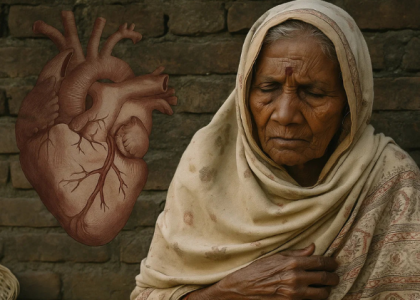Rajesh was only 42 when he felt a crushing pain in his chest during his morning walk. As a software engineer with no smoking habit and a vegetarian diet, he couldn’t believe he was having a heart attack. “But I’m not even overweight,” he told the emergency doctor. The doctor’s response surprised him: “You’re South Asian. We often see heart disease a decade earlier in your community.”
This story is all too common. While most Americans and Europeans develop heart disease in their 60s or 70s, South Asians (people from India, Pakistan, Bangladesh, Sri Lanka, and Nepal) often face these problems in their 40s and 50s.
What the Research Shows
Medical research confirms what many doctors have observed in their practices. According to the American Heart Association, South Asians in the United States have a much higher risk of heart disease compared to other ethnic groups, and it tends to develop 5-10 years earlier.
- Double the risk of developing heart disease compared to other groups
- Four times higher rate of heart disease at younger ages
- Higher risk even when at normal body weight
Even more concerning, research from the Cleveland Clinic shows that when South Asians do have heart problems, they tend to be more severe and affect more blood vessels.
What Makes South Asians Different?
Body Fat Distribution
- Hidden belly fat: South Asians often store fat around organs (called visceral fat), even when looking thin on the outside
- Think of it like: A car that looks clean on the outside but has internal engine problems
- Why it matters: This type of fat releases harmful chemicals that damage blood vessels
Metabolic Issues
- Higher diabetes rates: South Asians develop type 2 diabetes at earlier ages and at lower body weights
- Insulin resistance: Many South Asians have cells that don’t respond well to insulin, even before diabetes develops
- According to the Mayo Clinic, South Asians can develop diabetes with a BMI of just 23, while other groups typically develop it at BMI 25+
Diet and Lifestyle
- Traditional cooking methods: Heavy use of oils, ghee, and frying
- High carbohydrate intake: Rice, roti, and sweets can raise blood sugar levels
- Lower physical activity: Many South Asians reduce exercise after age 40
- Sitting jobs: Many in our community work in sedentary professions like IT, medicine, or office work
Cultural Factors
- Work stress: High achievement pressure in many South Asian families
- “Not talking about health”: Many don’t discuss health concerns until they’re serious
- Delaying care: “I’m just tired from work” is often actually a heart warning sign
Family History and Genetics
You might wonder: “Is this just in my genes? Can I do anything about it?”
While genetics do play a role, research from the National Institutes of Health shows that most of our higher risk comes from the factors we can change:
- Diet
- Physical activity
- Belly fat
- Blood sugar control
- Blood pressure management
The same study found that genetically, South Asians aren’t “destined” to have heart attacks. When South Asians adopt healthier lifestyles, their risk drops dramatically.
As Dr. Namratha Kandula of Northwestern University explains: “Your genes load the gun, but your lifestyle pulls the trigger.”
What You Can Do (Action Steps)
Know Your Numbers
- Get checked for diabetes (HbA1c test) yearly after age 35
- Check blood pressure at least twice a year
- Know your cholesterol levels (especially the “bad” LDL type)
- Measure your waist at home: Risk increases with waists over 35 inches (women) or 37 inches (men)
Move Your Body Daily
- Walk for 30 minutes every day
- Break up sitting time (stand up every 30 minutes)
- Try yoga or light weight training twice weekly
- Find activities you enjoy – dancing, gardening, and swimming all count!
Improve Your Diet
- Use less oil in cooking (try an air fryer!)
- Add more vegetables to your plate
- Choose brown rice instead of white
- Limit sweets to special occasions
- Try the “fist rule”: Protein portion size like your fist, carbs portion no larger than your fist
Reduce Stress
- Sleep 7+ hours each night
- Practice simple meditation (even 5 minutes helps)
- Connect with friends and family regularly
- Balance work with relaxation
Talk to Your Family
Heart disease often runs in families. If you’re reading this, please share it with your:
- Siblings
- Parents
- Children (especially those over 30)
- Extended family members
As the Cleveland Clinic points out, if one South Asian family member has early heart disease, others have a higher chance too. Early awareness saves lives.
Remember this important fact: South Asians who get regular check-ups and make lifestyle changes can live just as long and healthy as anyone else. The key is starting early – ideally in your 30s and 40s, before problems develop.
A Final Thought
Think of heart health like saving money – small deposits made consistently over time create the biggest impact. Each healthy meal, each walk, each check-up is a deposit in your heart health account.
Your heart has been beating for you since before you were born. Taking care of it now means it can keep supporting you for many more years to come.
Sources:
- American Heart Association. South Asians and Cardiovascular Risks. Heart.org.Link
- Journal of the American College of Cardiology. South Asian Ethnicity and Cardiovascular Risk.Link
- Cleveland Clinic. Center for Multicultural Cardiovascular Care.Link
- Mayo Clinic Health System. Risk Factors for Heart Disease.Link
- National Institutes of Health. MASALA Study: Mediators of Atherosclerosis in South Asians Living in America.Link




